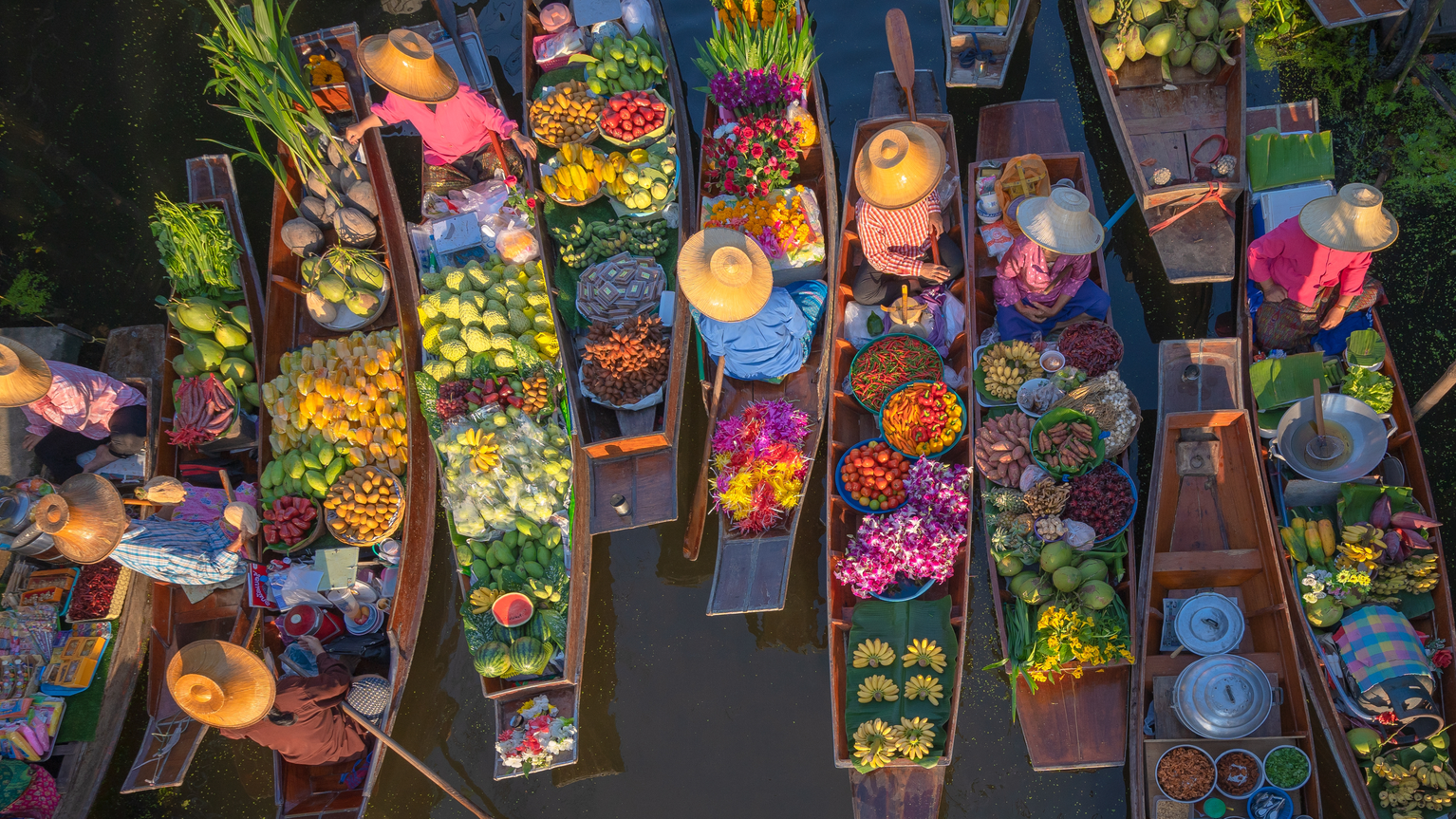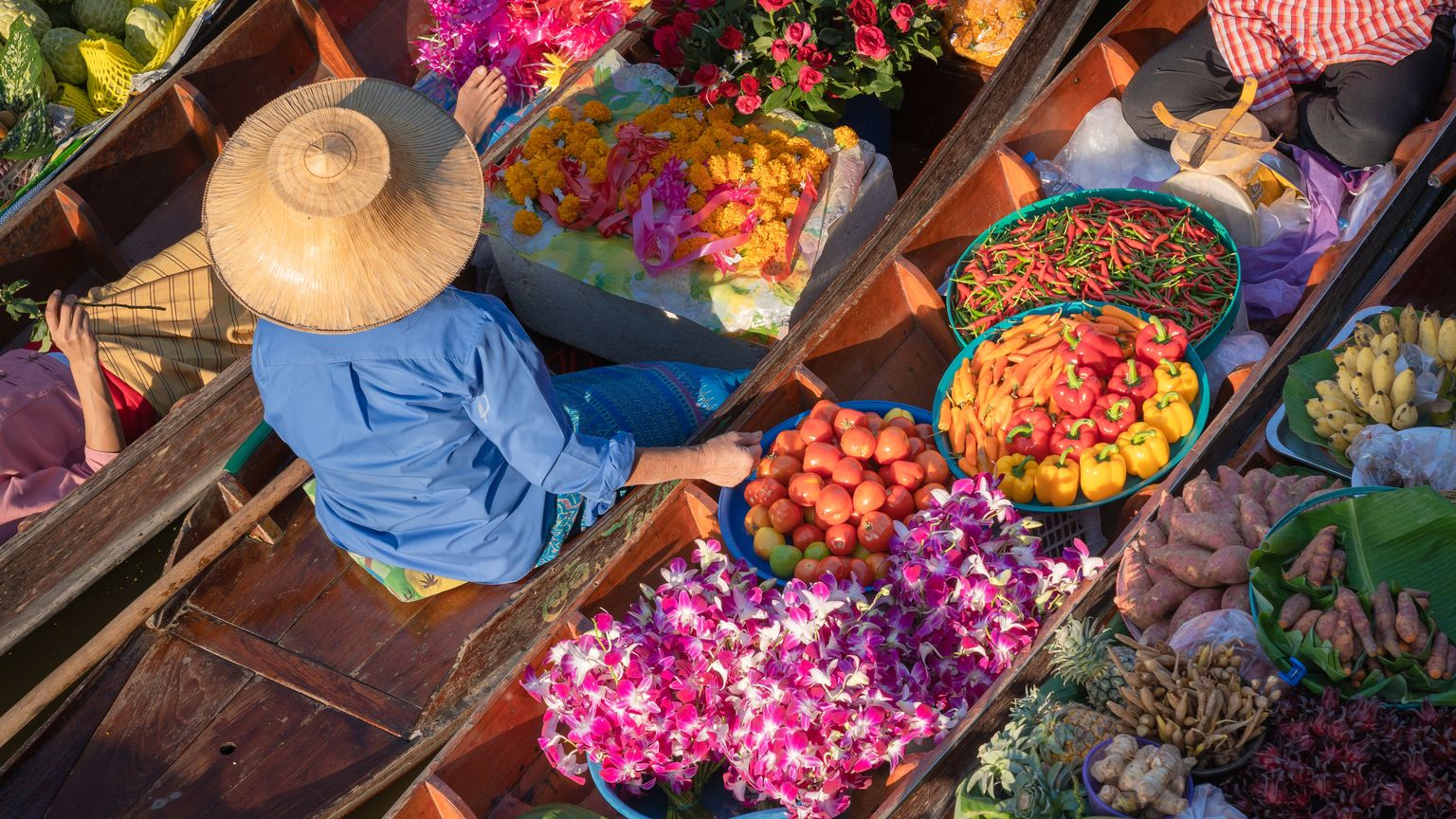
The top 10 foods to try in Thailand
From savory pad thai to sweet mango sticky rice, there are so many delicious foods to try in Thailand. See which dishes our experts swear are the 10 best traditional Thai foods to try on your trip.
Thailand’s cuisine is as vibrant and layered as its culture, shaped over centuries by regional traditions, fresh local ingredients, and a balance of distinct flavors. To truly experience the country, you can’t just see the temples or stroll through the markets—you have to taste it. From steaming bowls of tom yum soup to the crunch of perfectly stir-fried noodles, every dish tells a story of heritage and hospitality. After all, getting the chance to taste Thai food is one of the top reasons to take a guided tour of Thailand, and this guide is your one-stop-shop for insider info on the country’s most delectable foods to try in Thailand. If you’re wondering what to eat in Thialand, read on to see the bites that capture the heart of Thai cuisine.
Why Thai food is a must-try
Whether you’re digging into a spicy curry or a sweet slice of mango, every meal sings from start to finish. Have you heard about the four elements of cooking: salt, fat, acid, heat? Thai food perfectly balances these four components with a mix of sweet, sour, salty, and spicy flavors that dance on your tongue. (No wonder it’s one of the top travel destinations for the best food in the world.) At the heart of Thai cuisine is umami—the savory depth from fish sauce, shrimp paste, and slow-simmered broths that ties every flavor together.
Thailand’s food culture is about so much more than just eating. Meals become full-on travel experiences as you stroll through a night market and are surrounded by sounds and smells of sizzling woks and spices. Regional foods are infused with heritage and culture, creating distinct flavors: hearty, herbal dishes in the mountains of the north, fiery and fermented specialties in the northeast Isaan region, balanced classics in the central plains, and coconut-rich curries along the southern coast. The dishes reflect centuries of trade, migration, and local harvests, creating a cuisine that’s as diverse as Thailand itself. For travelers, this means even more local specialties to seek out on a tour of Thailand.
The best Thai food in Thailand
Thai food is vibrant, memorable, and a must-try part of any trip to the country. Whether you’re sampling street food at a lively night market or sitting down to nosh at a seaside cafe, here are the top 10 essential dishes to savor on your Thailand trip.
1. Khao neow mamuang (mango sticky rice)
You won’t find cloyingly sweet Thai dishes served for dessert. Thai people prefer to indulge in fresh fruit, and mango sticky rice is a fan favorite. This famous dish in Thai cuisine features slices of mango, sticky rice, coconut cream sauce, and roasted mung beans.
While the rice may look like jasmine rice, it’s actually a form of glutinous rice with a high starch content that makes it stick together when cooked—hence the name. The best way to eat this Thai dish is to cover your rice with the cream and tiny mung beans (they add extra texture and flavor!). Then, fill your fork with equal parts mango and rice and dig in.
Thai food tip: Keep your taste buds peeled for a vanilla-esque flavor as you enjoy this dish. That taste comes from pandan leaves, which are the Thai equivalent of vanilla extract.
2. Kanom krok (coconut pancakes)
Ditch the restaurants! Some of the best food you’ll eat during trips to Thailand is found at markets, and that’s the case with these tiny pancakes. They’re traditionally a half-dome shape, but the flatter ones aren’t any less delicious or authentic. The outside is cooked to crispy perfection and the inside is a pillowy cloud of dough and coconut flakes.
This popular Thai food is only about two inches in diameter and much sweeter than what you’d find at a diner in say, the U.S. or Canada. You’ll get 8-10 in an order, making it the perfect snack to share with a friend (but we won’t judge if you keep them all for yourself!).
Where to order this Thai dish: Search around the Damnoen Saduak Floating Market (one of our favorite things to do in Bankgkok) for vendors cooking these pancakes in their boats. They’re freshly made, will only run you about 60 baht (around $1.50), and are served in a bowl made from banana leaves. For other ideas on how to spend your free time (and more tips on what to eat) check out our Bangkok Travel Guide.
3. Khao soi (northern Thai curry noodles)
A lot of popular Thai dishes aren’t tied to a single region, meaning you can find them in every city you visit during Thailand tours. Khao soi is the exception. This curry is a specialty of northern Thailand and you’ll find it in Chiang Rai and Chiang Mai while on a guided tour of Thailand. So, dig in while you have the chance!
Smooth coconut cream and a fragrant curry paste featuring ingredients like black cardamom seeds, ginger, turmeric, and chili peppers make up the base. Chicken and egg noodles are added to round out the curry, which is easily one of the best Thai dishes. Don’t skimp on adding the crispy topping made from fried, uncooked noodles, as it adds an essential bit of crunch.
Thai food tip: Taste a homemade version of khao soi on the Lanna Family Home-Hosted Dinner excursion on our Thailand for Women: Bangkok, Chiang Mai & Krabi tour.
4. Gaeng khiao wan gai (Thai green curry)
There are two main types of curry you’ll find all throughout the country: red and green. Both are spicy, but the level of hotness comes down to whether fresh chili peppers or dried chili peppers are used. Fresh chili peppers are what bring the heat, whereas dried chili peppers don’t pack as big a punch. Red curries tend to be spicier, but don’t let that fool you—green curry is still one of the best Thai dishes to order if you want to dip your chopsticks into the spicy food world.
Even though green curries have a coconut milk base, don’t count on that to tamper the spice. The lack of fat in the milk means this Thai dish will always have a kick. Ladle the spicy concoction of curry, chicken, and veggies over a scoop of jasmine rice to experience one of the most famous Thai dishes at its absolute best.
Thai food tip: Look for bits of Thai eggplant and pea eggplants in your green curry. This is one way to know your meal is authentic, as these ingredients are only grown in Southeast Asia. Want to learn firsthand about all the aromatic ingredients that make Thai curry (and try it for yourself)? Join our Krabi Thai Cooking Class excursion on our A Week in Thailand: Bangkok & Krabi tour.
5. Pad krapow gai (Thai basil chicken)
Ask a local about the best Thai foods and we bet this chicken dish will be one food from Thailand they’ll say you can’t miss. A comforting and classic go-to, it features ground chicken cooked in oyster sauce and fish sauce. Chilies also make an appearance, as does Thai basil, which has a more anise-adjacent flavor than Italian basil.
Like any of the best Thai dishes, it’s served over jasmine rice. Do as the locals do and order this with a fried egg on top to take this popular Thai food to the next level.
Thai food restaurant recommendation: Places serving pad krapow gai are a dime a dozen, but if you’re looking for a sit-down restaurant, we love Roxane Cafe & Restaurant in Phuket.
6. Tom yum (hot and sour Thai soup)
It’s nearly impossible to pick a favorite from this list of the top Thai food dishes, but tom yum might squeak out the number one spot. Maybe it’s the way the aromatics bring out a freshness or how the fish sauce creates that perfect salty hit, but this soup is hands down one of the best Thai dishes to try on a tour of Thailand.
The brothy base has a signature hot-and-sour flavor profile thanks to the curry paste and lime juice. Shrimp is added just before it’s ready to serve and veggies like mushrooms and tomatoes also make an appearance. This savory soup is best enjoyed when it’s piping hot.
Thai food tip: Don’t try to eat the lemongrass and galangal floating in your tom yum. These aromatics add a depth to the soup, but their tough, fibrous nature makes them less than ideal to chew. You can learn all about the herbs and spices that make this dish and others so tasty during a cooking class on our Grand Tour of Thailand: Bangkok, Chiang Mai & Phuket.
7. Tom kha gai (Thai coconut chicken soup)
Want to try tom yum sans the seafood? This is one of the best Thai dishes for you. All the herbs and spices found in tom yum are also added to tom kha gai. But, instead of shrimp, chicken is used. The broth in tom kha gai is made from coconut milk and cream rather than a chicken stock, which cuts some of the spice.
Get the cream, meat, and veggies on your spoon for the perfect bite. As with tom yum, avoid eating the lemongrass and galangal. They’re just there to build the flavor of the dish.
Recommended Thai drink pairing: Wash down your tom kha gai with a glass of butterfly pea tea. Its signature indigo color comes from infusing the blossoms of the butterfly pea plant into the drink. It’s served both cold and hot, and you can’t go wrong either way.
8. Som tum (green papaya salad)
This savory salad features unripe, shredded papaya as the hero ingredient. In each forkful you’ll also find tomatoes, peanuts, and long beans. It’s one of the best Thai dishes to eat if you’re a fan of coleslaw—think of this as the Thai take on the American classic, sans the mayo.
The name and flavor of this dish comes from the sour elements (mainly limes and fish sauce) and how you use a mortar and pestle to crush the ingredients into a paste that coats the papaya strips.
Allergy warning: This salad usually contains shrimp paste. If you’re allergic to shellfish, make sure to have your Tour Director check with the chef before digging into this Thai food.
9. Pad thai (stir fry noodles)
This is one of the Thai dishes that’s synonymous with the country’s culinary identity. The best part of pad thai is that it’s customizable. You can order it with egg, shrimp, chicken, tofu, or any other proteins. The stir-fried rice noodles are the hero of this Thai dish, but the bean sprouts and crushed peanuts pull their weight to provide a crunch in every bite.
Thai food is often very affordable, and this one is no exception. A hearty serving will only run you 80 to 100 baht, or about $2 to $3 USD. That means you can order it and still have more than enough cash left over to try one of the many other Thai cuisines on this list.
Recommended Thai drink pairing: The best drink to sip with your pad thai? Thai tea, of course! This cold drink is made from condensed milk, tea, and sugar. It’s the perfect pick-me-up on a humid Thai day.
10. Popiah (spring rolls)
Steamed or fried. Meat-forward or stuffed with veggies. There’s no wrong way to enjoy a spring roll. Their small, shareable nature makes them one of the best Thai dishes to split with other travelers on tour. Nothing like breaking fried bread to make new friends at the start of your Thailand trip!
These are one of the best Thai foods to order day after day as each vendor will make them a bit differently. Some tried-and-true ingredients you’ll likely find in most spring rolls include bean sprouts, spring onions, carrots, cabbage, and mushrooms.
Thai food tip: There’s usually an orange-hued, sweet Thai chili sauce served with your spring rolls. Dunk away, as the sauce enhances the flavor of this already delicious Thai food.

Thai phrases for ordering food in Thailand
One of the best parts of exploring Thailand is diving into the local food scene, and a little insider know-how goes a long way. When ordering, a few basic Thai phrases can earn you a smile (and sometimes better service):
- Sawasdee khrap/sawasdee ka: Hello. (The ending depends on the speaker’s gender. Men use khrap and women use ka.)
- Ao an-nii khrap/ka: I would like this one please.
- Khawp khun khrap/ka: Thank you.
- Karuna: Please.
- Nueng: One.
- Song: Two.
- Mai pet: Not spicy.
- Pet nit-noi: A little spicy.
- Pet maak: Very spicy.
Thai food tip: Don’t let the fear of ordering food that’s too spicy deter you from trying street food. While its true that some Thai dishes pack a punch, vendors are used to adjusting for travelers’ palates. You can also use the handy phrase above to ask for “not spicy” if you’re unsure—authentic doesn’t have to mean overwhelming.
Tips for enjoying Thai street food
Thailand is famed for its lively night markets with vendors serving up many of the best Thai dishes on this list. Seeing it firsthand is a must-have experience, and you’ll do exactly that on our Highlights of Southern Thailand: Bangkok, Phuket & Krabi tour. Your Tour Director will be there to give you the best recommendations and help you order if needed, but here are a couple more tips to make the most of your travel journey.
Seek out stalls with plenty of locals lined up—that’s usually the freshest, safest bet for must-try Thai foods.
Wash your hands before and after eating, and if utensils are provided, use the spoon as your main tool and the fork to help push food onto it. (Thais rarely eat directly with a fork.)
For more mouthwatering street food inspiration, check out our list of the best street foods to eat in Southeast Asia.







)
)

)

)





















































